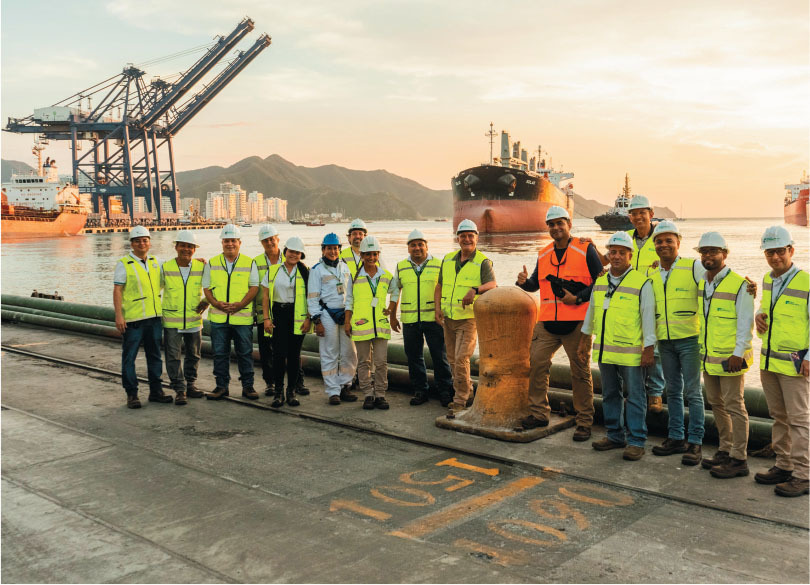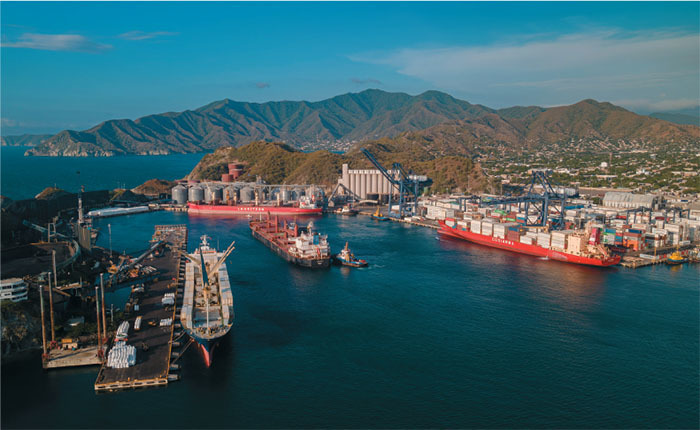
Like the preceding years, 2024 comes with unique challenges: The world struggles to return to prepandemic levels; Russian attacks on Ukraine continue; droughts hinder the strategic movement of vessels through the Panama Canal; the Israel-Palestine conflict has revived, triggering attacks on vessels in the Red Sea-Suez route.
With the concession of Colombian ports thirty years ago, public and private sectors took on the challenge of modernizing ports nationwide, with great success. Today, our ports are a regional and a global example of efficiency and competitiveness. However, unexpected circumstances have made world trade face difficult times.

Not a single risk matrix included a pandemic; nor the Russian aggression toward Ukraine that resulted in a war, with no end in sight; nor the impacts of climate change on the Panama Canal; and much less the rekindling of the Israel-Palestine war which, since late 2023, has included attacks on merchant vessels navigating the Red Sea-Suez route.
These circumstances and others dim the outlook for foreign trade, forcing ports to join efforts, share experiences and knowhow, and exchange information and ideas. It is time to work together for the common interest of ensuring a connected world. Historically, ports have seen each other as competitors, but, given the current geopolitical situation, foreign trade sustainability is experiencing a significant jolt. It is our responsibility as ports, governments, and shippers, to jointly develop the best conditions to bring stability to international trade.

Although the world now talks about deglobalization, not globalization, the latter continues to evolve and could lead to a radical change. Otherwise, it would mean going back to times before the economic coordination and integration that resulted from the fall of the Berlin Wall and the Cold War. The port sector must remain united in order to be stronger.
Hence, the announced agreement of operational collaboration between Maersk and Hapag-Lloyd AG (Gemini Cooperation), effective in 2025, that will result in a flexible and interconnected ocean network. Other shipping lines may follow the same path in the short- and medium-term, seeking a greater share in foreign trade logistics supply chain and door-to-door operations, from producers to consumers.

The Port of Santa Marta is strategic for foreign trade, given its privileged geographical position, natural draft, microclimate, and multimodality. As a major port for Colombian agriculture, we will continue to work and bet on expanding our exports despite the many global impacts.
We continue to focus on a strong rail system. Although 2023 saw one of the highest figures in rail transport at our port, we understand the huge potential to further develop this capacity. In other ports worldwide, we see that 70% of their cargo is moved by rail and only 30% by land. Rail also produces less environmental pollution per ton moved, a huge advantage when considering climate change.
Moreover, located in the oldest city in Colombia and the second oldest in South America, Santa Marta offers spectacular sights, such as the breathtaking Sierra Nevada, Ciudad Perdida, and Parque Tayrona, favorites of national and international visitors. A cruise terminal is, no doubt, a pending city project for the further growth of the area.

The Port of Santa Marta firmly believes that good education for future generations, generating job opportunities and teamwork, will result in the betterment of all ports in our region. We have the willingness and the attitude to do our part to ensure safe and efficient trade.
We would like to thank the Port of Barranquilla for the excellent organization of the 31st Latin American Convention of Ports, held on December 4–6, 2023. And we are certain that the 32nd Convention – this December in the beautiful resort city of Cancun, one of the world’s leading cruise ports – will be the perfect setting to hand over the leadership of AAPA’s Latin American Port Delegation to a sister port and, together, strive to create more tenacious ports, stronger nations, and a more united region.
 AAPA Seaports
AAPA Seaports


